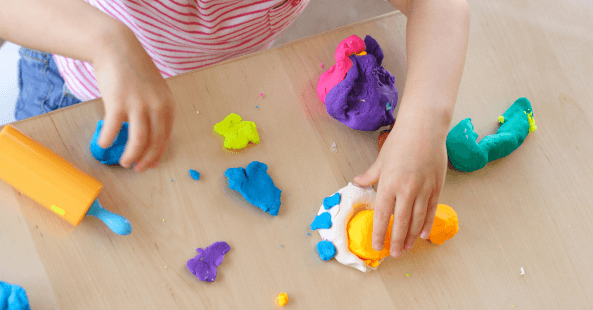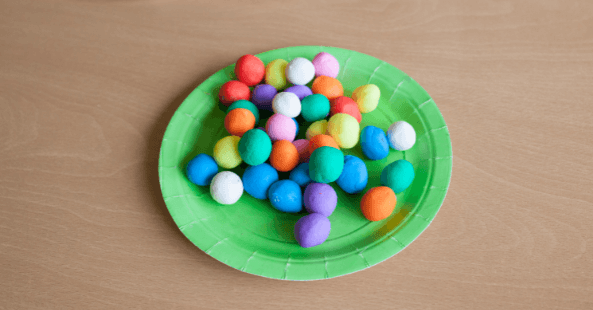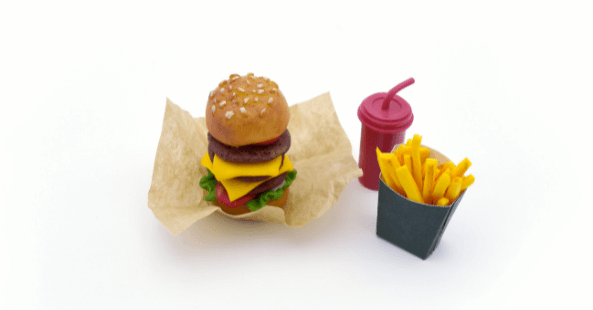How do we use Play Dough in the classroom?
Playdough is a universal toy – excellent for relaxing and creativity – but not usually something that you may consider for your EFL classroom. Play dough however is an extremely useful component and this article will take you through the various ways that it can be effectively used to develop various aspects of your EFL class.
The first thing to consider is where to get the play dough from. It is possible to purchase the pots of play dough from toyshops or even some grocery stores. This is fine if you have very small classes or if your school is willing to help you with the purchase costs. However, for many with large classrooms and an expectation that you need to purchase your own educational materials, the best option is to make your own.
There are various ways of making playdough – some with simply hot water and others with slowly cooking up. Both ways will be outlined here:
Cooked playdough (both on the stove top and in the microwave)
Ingredients:
2 cups plain flour
1 cup of salt
2 cups of water
2 tablespoons of oil
4 teaspoons of cream of tartar
Food colouring
Recipe:
Mix the ingredients in a bowl (if microwaving) or a saucepan (if cooking)
Either cook slowly on the stove top stirring consistency until the mixture changes consistency and becomes play dough like ( you know it is ready when you can roll it between your hands and there is no sticky residue left on your hands )
Alternatively put the mixture in the microwave on medium heat for about five minutes (it is suggested that you start with 3 minutes and continue at 30 second intervals to avoid burning)
Leave the mixture to cool before putting in a sealed plastic bag or plastic box.
Hot water method
Ingredients:
2 cups plain flour
2 tablespoons vegetable oil (baby oil and coconut oil work too)
1/2 cup salt
2 tablespoons cream of tartar
1 to 1.5 cups boiling water (adding in increments until it feels just right)
Food colouring (optional)
Few drops glycerine (optional)
Recipe:
Mix the flour, salt, cream of tartar and oil in a large mixing bowl
Add food colouring to the boiling water then into the dry ingredients
Stir continuously until it becomes a sticky, combined dough
Add the glycerine (optional)
Allow it to cool down then take it out of the bowl and knead it vigorously for a couple of minutes until all of the stickiness has gone. Please note that this is the most important part of the process, so it is important to keep moulding and kneading until it is the perfect play dough consistency.
If it remains a little sticky then add a touch more flour until just right
Once you have mastered the technique of making your own play dough then you can enhance it according to topics e.g. during a space theme you can make black play dough and add sparkles, when investigating the five senses you can add different scents to the playdough or different textures etc.
So we have the play dough – what is next? In general, terms, play dough can be used to develop fine motor control skills through the rolling, squishing, flattening and squashing of the dough. For young children, this fine motor control is needed to develop children’s muscles that are needed for holding a pencil and cutting with scissors.
Playdough can be used in the classroom as part of the circle time, the main activity or as a filler for when pupils have finished their work early.
Using play dough as part of circle time
If you want to use playdough as part of circle time it is important to first test the playdough on the surface as playdough easily becomes stuck to fabrics such as carpets or wool mats ( although plastic matting is fine ) Examples of how you can use playdough for circle time activities include :
- The teacher saying an item word e.g. car / bicycle / cat / chicken etc. and pupils working to make this item to show understanding ( although this takes longer than simply holding up a flashcard and asking pupils to name it, this practical activity will ensure that all pupils are engaged and you will be able to develop a much larger range of vocabulary than the flashcard method )
- The teacher saying a number and pupils either making that number of play dough balls or making the number itself ( this can also be used for one more / one less )
- Pupils either making a tick or a cross from playdough to answer questions ( by making the response an exciting event pupils are more likely to be able to maintain concentration and answer a larger number of questions )
- For very young pupils – hide a piece of play dough inside a plastic egg – encourage pupils to name the egg colour and encourage them to squeeze the egg until it pops open ( thereby developing colour skills as well as fine motor strength, hand-eye coordination, and bilateral skills)
The uses are limitless and it is through actively involving the pupils in the activity that takes your lesson from a flashcard frustration to one in which pupils are eager and excited for more.
Using play dough as a main lesson focus
In addition to using play dough as part of your circle time, you can use play dough as a main activity within an ESL lesson through activities such as:
- Pupils getting into pairs – one person has a card ( word or picture ) and they have to say that word for their partner who needs to make that item from playdough
- Group projects – pupils working collectively to e.g. make as many things from play dough relating to a key topic as possible e.g. the topic of things in a kitchen and write down labels to explain what the play dough items are etc.
- Pupils brainstorming as many vocabulary words as possible and then making the corresponding play dough items ( through working practically pupils will be encouraged to continue at the this activity for a much longer periods of time than if simply making word maps etc. )
- Using play dough to set up a scene e.g.one play dough character who is a teacher, another who is a student and pupils taking on different roles as the playdough characters ( through encouraging the pupils to be a playdough character instead of themselves they will feel less self-conscious and more likely to speak )
Pupils can develop their vocabulary through making play dough scenes
Play dough cards
In addition to working with the play dough itself, the use of playdough can be greatly enhanced through the use of play dough cards. These can be printed out (in colour or black or white) and laminated (so that the play dough does not stick to it) and can be used for a whole range of language-based activities.
For the younger pupils, there are a wide range of play dough cards that encourage children to complete a picture – for example:
People play dough mats – https://picklebums.com/people-play-dough-mats/
Bugs – https://picklebums.com/beautiful-bugs-playdough-mats-free-printable/
Gardens – https://picklebums.com/gardening-growing-play-dough-mats-free-printable/
Food – https://picklebums.com/fun-food-play-dough-mats/
For older pupils play dough cards that require children to trace over letters to make words or make a letter to complete a word are very popular.
For example:
Alphabet and numbers – https://www.funwithmama.com/play-dough-mats-alphabets-numbers-and-arabic-numbers/
Bugs and numbers – https://modernpreschool.com/bug-catcher-counting-number-play-dough-mats/
Numbers – https://stayathomeeducator.com/cactus-theme-number-formation-playdough-mats/
There are a wide range of free play dough mats on the internet which are easy to download and laminate
Once you start looking you will be amazed at the huge range of free play dough mats out there and how you can use them for almost any topic or area of focus.
Playdough really is an invaluable part of your teaching toolbox. Easy to make, safe, attractive and easy to use, the uses of play dough within an ESL classroom is infinite. So get your ingredients together and start mixing – happy play doughing!
Are you facing difficulties in finding and securing teaching positions in Vietnam? Are visa procedures causing you trouble? Feeling overwhelmed and directionless upon your arrival in Vietnam for teaching assignments? Don’t worry, VTJ’s English Teaching Placement in Vietnam (EPIV) Program 2024 provides comprehensive support to solve ALL the matters.
👉👉👉 Click HERE to request free consultation







